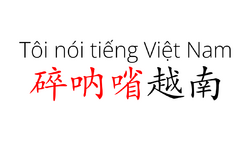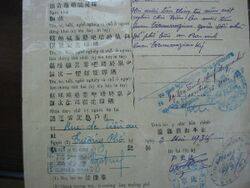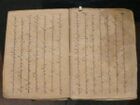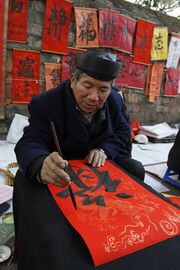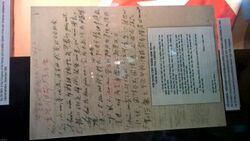History of writing in Vietnam
Topic: Social
 From HandWiki - Reading time: 20 min
From HandWiki - Reading time: 20 min
Spoken and written Vietnamese today uses the Latin script-based Vietnamese alphabet to represent Vietnamese words which are of Chinese origin (Hán-Việt, or Sino-Vietnamese), native Vietnamese words (thuần Việt), and other foreign loanwords. Historic Vietnamese literature was written by scholars in Nôm and before that Hán (Chinese characters).
During ancient times, the ancestors of the Vietnamese were considered to have been Proto-Austroasiatic (also called Proto-Mon–Khmer) speaking people, possibly traced to the ancient Dong Son culture. Modern linguists describe Vietnamese as having lost some Proto-Austroasiatic phonological and morphological features that the original Vietnamese language had. This was noted in the linguistic separation of Vietnamese from Vietnamese-Muong roughly one thousand years ago.[1][2][3] From 111 BC up to the 20th century, Vietnamese literature was written in Văn ngôn (Classical Chinese or Literary Chinese), using chữ Hán (Chinese characters) and then also Nôm from the 10th century to 20th century (Chinese characters adapted for vernacular Vietnamese).[4][2]
Chữ Nôm began to be used as early as the 8th century in prose fiction and poetry in Vietnamese and had gained widespread use by the 10th century. It was formalized under the Hồ and the Tây Sơn dynasties. Chữ Nôm used chữ Hán for Sino-Vietnamese vocabulary and an adapted set of characters to transcribe native Vietnamese, with Vietnamese approximations of Middle Chinese pronunciations.[5] The two concurrent scripts existed until the era of French Indochina when chữ Quốc ngữ, the Latin alphabet, gradually became the current written medium of literature.[6] In the past, Sanskrit and Indic texts also contributed to Vietnamese literature either from religious ideas from Mahayana Buddhism, or from historical influence of Champa and Khmer.
Terminology
In Vietnamese, Chinese characters go by several names, but all refer to the same script:
- Chữ Hán (𡨸漢) or Hán tự (漢字): "words of Hán" or "Hán characters/words". 漢字 is also pronounced as Hanzi in Standard Chinese, Hanja in Korean, and Kanji in Japanese.
- Hán văn (漢文): "Han writing" or "Han literature",[7][8] also pronounced as Hanwen in Standard Chinese, Hanmun in Korean, and Kanbun in Japanese. Meaning Classical Chinese.
- Chữ Nho (𡨸儒, "words of Confucians").[9][10][11]
The Vietnamese word chữ 𡨸 (character, script, writing, letter) is derived from a Middle Chinese pronunciation of 字 (Modern Mandarin Chinese in Pinyin: zì), meaning 'character'.[12]
Từ Hán Việt (詞漢越, "Sino-Vietnamese words") refers to cognates or terms borrowed from Chinese into the Vietnamese language, usually preserving the phonology of the original Chinese that was introduced to Vietnamese. As for syntax and vocabulary this Sino-Vietnamese language was no more different from the Chinese of Beijing than medieval English Latin was different from the Latin of Rome. Its major influence comes from Vietnamese Literary Chinese (Chữ Hán).[13]
The term chữ Nôm (𡨸喃, "Southern characters") refers to the former transcription system for vernacular Vietnamese-language texts, written using a mixture of original Chinese characters and locally coined Nôm characters not found in Chinese to phonetically represent local Vietnamese words, meanings and their sound.[14][15] However, the character set for chữ Nôm is extensive, containing up to 37,000 characters, and many are both arbitrary in composition and inconsistent in pronunciation.[16][17]
Hán Nôm (漢喃, "Hán and chữ Nôm characters") may mean both Hán and Nôm taken together as in the research remit of Hanoi's Hán-Nôm Institute, or refer to texts which are written in a mixture of Hán and Nôm, or some Hán texts with parallel Nôm translations.[18] There is a significant orthographic overlap between Hán and Nôm and many characters are used in both Hán and Nôm with the same reading.[19] It may be simplest to think of Nôm as the Vietnamese extension of Han characters. The term chữ quốc ngữ (𡨸國語, "national language script") means Vietnamese written in the Latin alphabet.
History
Chữ Hán

Chinese characters are specifically called chữ Hán (𡨸漢), chữ Nho (𡨸儒) or Hán tự (漢字, lit. Han character) in Vietnamese. Chữ Hoa or tiếng Hoa is commonly used to describe Mandarin Chinese, as well as tiếng Tàu for Chinese in general. Possibly even a thousand years earlier, in the late first millennium BC, Yuè elites in what is now southern China may have already adopted a form of writing based on Chinese characters to record terms from their own languages.[20] During the Chinese rule from 111 BC to 905 AD, Chinese characters had been used as the official writing of the region. Local texts written in Chinese probably also included some characters adapted to represent Proto-Viet-Mường sounds, usually personal names or Vietic toponyms that had no Chinese equivalent.[20] According to some scholars, the adoption chữ Hán or Hán tự had been started by Shi Xie (137–226), but many disagree.[20] The first wholly vernacular Vietnamese writing transcribed in Chinese characters started in late-Tang period, around ninth century by Liêu Hữu Phương.[21]
These writings were at first indistinguishable from contemporaneous classical Chinese works produced in China, Korea or Japan. These include the first poems in Literary Chinese by the monk Khuông Việt (匡越), the Nam Quốc Sơn Hà (南國山河), and many Confucian, Daoist, and Buddhist scriptures.[2][22][23][24]
By 1174, chữ Hán had become the official writing script of the court, mainly used by administration and literati, and continued to serve this role until the mid-19th century during French colonial rule when the traditional writing system was abolished in favour of transliterated chữ quốc ngữ.[25]
Sino-Vietnamese readings of chữ Hán
In Vietnam, chữ Hán texts were read with the vocalization of Chinese text, called Hán văn (漢文), similar to Chinese on-yomi in Japanese kanbun (漢文), or the assimilated vocalizations in Korean hanmun (한문/漢文).[26][27] This occurred alongside the diffusion of Sino-Vietnamese vocabulary into vernacular Vietnamese,[28] and created a Sinoxenic dialect.[29] The Sinologist Edwin G. Pulleyblank was the one of the first linguists to actively employ "Sino-Vietnamese" to recover earlier histories of China.[30]
Chữ Nôm
From the 13th century, the dominance of Chinese characters began to be challenged by chữ Nôm, a different writing system based on the Chinese script to transcribe native Vietnamese words. These were even more difficult than Chinese characters themselves. Nôm script borrowed Chinese characters in their phonetic and semantic values to create new characters.[31]
Whilst designed for native Vietnamese words, Nôm required the user to have a fair knowledge of chữ Hán, and thus chữ Nôm was used primarily for literary writings by cultural elites (such as the poetry of Nguyễn Du and Hồ Xuân Hương), while almost all other official writings and documents continued to be written in classical Chinese until the 20th century.[32][33]
Though technically different from chữ Hán, it is simplest to think of Nôm as a derivation of chữ Hán for vernacular Vietnamese, with modifications and new Vietnamese-coined logograms. Together, they are called Hán Nôm. Ultimately Nôm was deemed an inferior method of enabling mass communication and transcription of Vietnamese speech, with the Latin script seen as more practical.
Quốc Âm Tân Tự
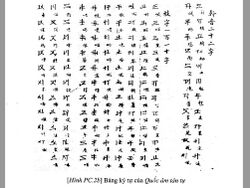
Quốc Âm Tân Tự (chữ Nôm: 國音新字), literally 'new script of national sound (language)', was a writing system for Vietnamese proposed in the mid-19th century. Two documents written on this type of script (four pages each) are kept at the Institute for the Study of Han Nom: An older unnamed manuscript, and a more recent copy called Quoc Am Tan Tu (國音新字). There is no information in the text of the Quốc Âm Tân Tự that indicates the specific date and year this work was written. Based on the fact that in the preface of the work the last stroke of the character "華" (Hoa) has been omitted due to naming taboo), it can be guessed that this text was written during the reign of Emperor Thiệu Trị (whose mother's name was "Hồ Thị Hoa" 胡氏華). At the end of the text's preface, there is a line "五星聚斗南城居士阮子書" (Ngũ Tinh Tụ Đẩu Nam Thành Cư Sĩ Nguyễn Tử Thư). Through this inscription, it can be known that the author of Quốc Âm Tân Tự is a layman with the surname Nguyễn (阮) in Nam Định citadel (南定) with the nickname Ngũ Tinh Tụ Đẩu (五星聚斗).[35]
Quốc Âm Tân Tự is a type of phonetic script made from the strokes of Chinese and Nôm characters, similar to Hiragana and Katakana of Japanese or Zhuyin Fuhao (bopomofo) in Chinese. Based on the pronunciation of Vietnamese, there are 22 cán tự (幹字) and 110 chi tự (枝字) ("cán" means trunk, "chi" means branches, "tự" means character). Cán tự is used to record the first consonant, and the chi tự is used to write the rhyme. Each character is named with a word that rhymes "ông" with the first consonant being the first consonant that the character signifies, for example, the word "đ" denotes the consonant "đ" is named "đông" (similar to today, the Vietnamese call the consonant "đ" the sound "đờ"). Quốc Âm Tân Tự does not distinguish between "d" and "gi" as in Quốc ngữ (possibly because the author followed the Northern accent when "d" and "gi" sound almost the same). There is a shank used to record the initial consonant /ʔ/, which is named "ông".
The author of Quốc Âm Tân Tự used four stroke types: (一), (丨), (丶), (丿) (also including "㇏" as a variant of "丶") to create the characters. Every character (including all "trunk" and "branch" characters) has a total of four strokes. Most of the characters only use two or three stroke types, but the total number of strokes is exactly four.
Quốc Âm Tân Tự uses the traditional "tone" division, the tones are divided into four categories: "bình" (平), "thượng" (上), "khứ" (去), "nhập" (入). Each type is further divided into two degrees, "yin" (陰) and "yang" (陽). There are eight tones in total:
- Âm bình or yīn píng 陰平: is thanh ngang as it is called today.
- Dương Bình or yáng píng 陽平: is thanh huyền as it is called today.
- Âm thượng or yīn shàng 陰上: is thanh hỏi as it is called today.
- Dương thượng or yáng shàng 陽上: is thanh ngã as it is called today.
- Âm khứ or yīn qù 陰去: is thanh sắc in words that, when written in Quốc ngữ, do not end with "c", "ch", "p", or "t".
- Dương khứ or yáng qù 陽去: is thanh nặng in words that, when written in Quốc ngữ, do not end with "c", "ch", "p", or "t".
- âm nhập or yīn rù 陰入: is thanh sắc in words that, when written in Quốc ngữ, do end with "c", "ch", "p", or "t".
- "Dương nhập or yáng rù" 陽入: is a heavy bar in words that, when written in Quốc ngữ, do end with "c", "ch", "p", or "t".
Tones of "âm" ("yīn") degree are marked with a small semi-circle, and tones of "dương" ("yáng") degree are marked with a small circle mark. To indicate serenity, the tone is placed next to the "left foot" of the word, with the bar mark placed next to the "left shoulder" of the word, with the accent bar placed next to the "right shoulder" of the text, with the accent bar placed next to the "right foot" of the text.
Quốc Âm Tân Tự can be written vertically or horizontally like Han characters and Nôm characters, and is a set of phonetic scripts created by the Vietnamese themselves (when chữ Nôm is a logographic system created by the Vietnamese, Quốc Ngữ is a phonetic script created by a foreigner). When Quốc Âm Tân Tự was born, it did not have enough time to be completed and popularized like Kana in Japan, because the political and social situation of Vietnam was too complicated at that time due to the gradual weakening of Nguyễn rule and the beginning of the French invasion.
Chữ Quốc ngữ
Vietnamese in Latin script, called Chữ Quốc ngữ, is the currently-used script. It was first developed by Portuguese missionaries in the 17th century, based on the pronunciation of Portuguese language and alphabet. For 200 years, chu quoc ngu was mainly used within the Catholic community.[36] However, during French administration, the alphabet was further modified and then later made a part of compulsory education in 1910.[37]
Meanwhile, the use of chu Hán and chữ Nôm started to decline. At this time there were briefly four competing writing systems in Vietnam; chữ Hán, chữ Nôm, chữ Quốc ngữ, and French.[38] Although Gia Định Báo, the first Vietnamese newspaper in chữ Quốc ngữ, was founded in 1865, Vietnamese nationalists continued to use chữ Nôm until after the First World War.
After French rule, chữ Quốc ngữ became the favored written language of the Vietnamese independence movement.[39]
BBC journalist Nguyễn Giang noted that while the early Christian missionaries are credited with creating the Vietnamese alphabet, what they did was not unique or difficult and would have been done later without them had they not created it.[40] Giang further stated that the main reason for the popularisation of the Latin alphabet in the Nguyễn dynasty (the French protectorates of Annam and Tonkin) was because of the pioneering efforts by intellectuals from French Cochinchina combined with the progressive and scientific policies of the French government in French Indochina, that created the momentum for the usage of chữ Quốc ngữ to spread.[40] Giang stated that the Tonkin Free School only removed the stigma against using chữ Quốc ngữ for the Nguyễn dynasty elites, but did not actually popularise it.[40]
An important reason why Latin script became the standard writing system of Vietnam but did not do so in Cambodia and Laos that were both dominated by the French for a similar amount of time and existed within the same colonial framework has to do with the fact that the Emperors of the Nguyễn dynasty heavily promoted its usage.[40] According to the historian Liam Kelley in his 2016 work "Emperor Thành Thái's Educational Revolution" neither the French nor the revolutionaries had enough power to spread the usage of chữ Quốc ngữ down to the village level.[40] It was by imperial decree in 1906 that the Thành Thái Emperor parents could decide whether their children will follow a curriculum in Hán văn (漢文) or Nam âm (南音, "Southern sound", the contemporary Nguyễn dynasty name for chữ Quốc ngữ).[40] This decree was issued at the same time when other social changes, such as the cutting of long male hair, were occurring.[40]
From the first days it was recognized that the Chinese language was a barrier between us and the natives; the education provided by means of the hieroglyphic characters was completely beyond us; this writing makes possible only with difficulty transmitting to the population the diverse ideas which are necessary for them at the level of their new political and commercial situation. Consequently we are obliged to follow the traditions of our own system of education; it is the only one which can bring close to us the Annamites of the colony by inculcating in them the principles of European civilization and isolating them from the hostile influence of our neighbors.[41]
– In a letter dated January 15, 1866, Paulin Vial, Directeur du Cabinet du Gouverneur de la Cochinchine
As a result of extensive education in chữ Quốc ngữ, Vietnamese people of today who are not versed in Chinese characters or Chinese-origin words are unable to read earlier Vietnamese texts written in Hán-Nôm. The Hán Nôm Institute is the national centre for academic research into Hán-Nôm literature. Although there have been movements to restore Hán-Nôm in Vietnam, via education in schools or usage in everyday life, almost all ancient poems and literary texts have been translated to and converted to chữ Quốc ngữ, which makes the need for literacy in Hán-Nôm almost obsolete. However, many Vietnamese find it difficult to detach themselves from their Hán-Nôm legacy, and may still feel an intimate relationship with Chinese characters.
Sanskrit, Cham, Khmer and Indic scripts
Sanskrit texts have often been passed over and translated to Vietnamese indirectly from Chinese texts via religious teachings from Buddhist sectors, or directly, such as from Champa and Khmer. One of the most significant landmarks still remaining to this day is the ancient Mỹ Sơn Hindu Temple which has Sanskrit and Champa inscriptions.[42] The Võ Cạnh inscription is also the oldest Sanskrit inscription ever found in Southeast Asia, a legacy of Lâm Ấp, Champa, and Funan kingdoms.[43][44] The most well-known modern Vietnamese phrase with Sanskrit phrase is from common religious Buddhist mantra नमोऽमिताभाय/ Namo Amitābhāya (Nam mô A Di Đà Phật / 南無阿彌陀佛), meaning, "Hail Buddha of Infinite Light" (translated directly from Sanskrit) or "I pay homage to the Enlightened One immeasurable" / "I turn to rely on the Enlightened One immeasurable".[45] Additionally, many sites in Vietnam have names that are Khmer in origin, from when the land was under Funan and Chenla reign, etc. For example, ស្រុកឃ្លាំង Srok Khleang is written as Sóc Trăng in Vietnamese. Hence, there is some Khmer influence in Mekong Delta, Vietnam.
Tai Dam script
The Tai Viet script is the abugida used by the Tai Dam people and other Southwest Tai-speaking peoples in Northern Vietnam, from 16th century to present-day, derived from the Fakkham script of Tai Lanna people.
Jawi script
From the onset of the 18th century, Cham communities in the Mekong Delta began adopting the Arabic-derived Jawi script. Today, the Western Cham (Cambodian and Mekong Delta Cham whom majority are Sunni Muslims) use both Jawi and Latin alphabets to write their language, compared to the Eastern Cham who are mostly Bani Muslims and Balamon and still using Akhar Thrah (traditional) script and Latin alphabets.
Modern usage of chữ Hán and chữ Nôm
Individual chữ Hán are still written by calligraphers for special occasions such as the Vietnamese New Year, Tết.[46] They are still present outside Buddhist temples and are still studied for scholarly and religious purposes.
Vietnamese calligraphy (Thư pháp chữ Việt) has enjoyed tremendous success at the expense of chữ Hán calligraphy since its introduction in the 1950's.
Since the mid-1990s there has been a noticeable resurgence in the teaching of Chinese characters, both for chữ Hán and the additional characters used in chữ Nôm. This is to enable the study of Vietnam's long history as well as cultural synthesis and unification.[47]
For linguists, the Sino-Vietnamese readings of Chinese characters provide data for the study of historical Chinese phonology and reconstruction of the Old Chinese language.
Additionally, many Vietnamese may study Chinese characters as part of learning Chinese, Japanese, or Korean (since Japanese and Korean have a high concentration of Chinese-cognate words). In the process, they also end up with some measure of fluency with Hán–Nôm characters.
The significance of chữ Hán and chữ Nôm has occasionally entered western depiction of Vietnam, especially since French rule. Novelist E. M. Nathanson, for example, mentions chu Hán in A Dirty Distant War (1987).[48]
Mixed script
It is known that Ho Chi Minh wrote in a mixed Vietnamese Latin–Hán-Nôm script.
| Hindu-Arabic numerals | Chữ Hán | Sino-Vietnamese pronunciation | Chữ Nôm | Modern chữ Quốc ngữ | Pinyin for comparison |
|---|---|---|---|---|---|
| 0 | 〇/零 | linh | 空 | không | líng |
| 1 | 一 | nhất | 𠬠 | một | yī |
| 2 | 二 | nhị, nhì | 𠄩 | hai | èr |
| 3 | 三 | tam | 𠀧 | ba | sān |
| 4 | 四 | tứ, tư | 𦊚 | bốn | sì |
| 5 | 五 | ngũ | 𠄼 | năm | wǔ |
| 6 | 六 | lục | 𦒹 | sáu | liù |
| 7 | 七 | thất | 𦉱 | bảy | qī |
| 8 | 八 | bát | 𠔭 | tám | bā |
| 9 | 九 | cửu | 𠃩 | chín | jiǔ |
| 10 | 十 | thập | 𨑮 | mười | shí |
| 100 | 百 | bách | 𤾓 | trăm | bǎi |
| 1000 | 千 | thiên | 𠦳 | nghìn | qiān |
| 10,000 | 萬 | vạn | 𨑮𠦳 | mười nghìn | wàn |
| 1,000,000 | 百萬 | bách vạn | 兆 | triệu | bǎi wàn |
From the Sino-Vietnamese readings, some words have ended up in common vernacular Vietnamese. For example, "nhất" (一) has come to mean "first" and "tứ" (四) has come to mean fourth in vernacular Vietnamese. Modern Vietnamese can be thought of as a romanised or transliteration rendering of common Hán-Nôm words, that has since been used as the main medium of language in Vietnam.
See also
Related romanisations:
- Portuguese Alphabet (the Vietnamese alphabet was largely based on the conventions of the Romance languages)
References
- ↑ 清水政明, Masaaki Shimizu (in en). The Mường features in the written Ancient Vietnamese. https://www.academia.edu/19872044.
- ↑ 2.0 2.1 2.2 "Vietnamese literature" (in en). https://www.britannica.com/art/Vietnamese-literature.
- ↑ LaPolla, Randy J. (2010). "Language Contact and Language Change in the History of the Sinitic Languages". Procedia - Social and Behavioral Sciences 2 (5): 6858–6868. doi:10.1016/j.sbspro.2010.05.036. ISSN 1877-0428.
- ↑ Nguyễn, Tri Tài (2002). Giáo trình tiếng Hán. Tập I: Cơ sở. Nhà xuất bản Đại học Quốc gia Thành phố Hồ Chí Minh. p. 5.
- ↑ Asian & Pacific quarterly of cultural and social affairs – Volumes 20–21 Cultural and Social Centre for the Asian and Pacific Region 1988 – Page 7 "... known script that was used by the Vietnamese, the "Southerners," to transcribe their language, in contrast to the Chinese ideographs (called chữ Hán i.e., "Chinese script," or chữ nho i.e. "Confucian script") of the "Northerners," the Chinese."
- ↑ Vietnam 10 – Page 522 Nick Ray, Yu-Mei Balasingamchow, Iain Stewart – 2009 "For centuries, the Vietnamese language was written in standard Chinese characters (chữ nho). Around the 13th century, the Vietnamese devised their own writing system called chữ nôm (or just nôm), which was created by combining two Chinese words or by using single Chinese characters for their phonetic value. Both writing systems were in use until the 20th century – official business and scholarship was conducted in chữ nho, while chữ nôm was used for popular literature. The Latin-based quốc ngữ script, widely used since WWI, was developed in the 17th century by Alexandre de Rhodes (see the boxed text, right). Quốc ngữ served to undermine the position of Mandarin officials, whose power was based on traditional scholarship in chữ nho and chữ nôm, scripts that were largely inaccessible to the masses."
- ↑ Hội Khai-trí tiến-đức (1954). Việt-nam tự-điển. Văn Mới. p. 228.
- ↑ Đào, Duy Anh (2005). Hán-Việt từ-điển giản yếu. Nhà xuất bản Văn hoá Thông tin. pp. 281, 900.
- ↑ Nguyễn, Tài Cẩn (2001). Nguồn gốc và quá trình hình thành cách đọc Hán Việt. Nhà xuất bản Đại học quốc gia Hà Nội. p. 16.
- ↑ Hội Khai-trí tiến-đức (1954). Việt-nam tự-điển. Văn Mới. pp. 141, 228.
- ↑ Đào, Duy Anh (2005). Hán-Việt từ-điển giản yếu. Nhà xuất bản Văn hoá Thông tin. p. 281.
- ↑ Nguyễn, Tài Cẩn (1995). Giáo trình lịch sử ngữ âm tiếng Việt (sơ thảo). Nhà xuất bản Giáo dục. p. 47.
- ↑ Marr, David G. (1984), Vietnamese Tradition on Trial, 1920–1945, p. 141, "Because the Chinese characters were pronounced according to Vietnamese preferences, and because certain stylistic modifications occurred over time, later scholars came to refer to a hybrid 'Sino-Vietnamese' (Han-Viet) language. However, there would seem to be no more justification for this term than for a Fifteenth Century 'Latin-English' versus the Latin written contemporaneously in Rome."
- ↑ Nguyễn, Khuê (2009). Chữ Nôm: cơ sở và nâng cao. Nhà xuất bản Đại học Quốc gia Thành phố Hồ Chí Minh. pp. 5, 215.
- ↑ Hugh Dyson Walker East Asia A New History −2012 Page 262 "...chu nom, Vietnamese transcription, using Chinese and nom characters for Vietnamese sounds."
- ↑ Denecke 2017, p. 525.
- ↑ Hannas, Wm. C. (1997). Asia's Orthographic Dilemma. Honolulu: University of Hawai'i Press. p. 82. ISBN 9780824818920. https://books.google.com/books?id=aJfv8Iyd2m4C&pg=PA82. "The linguistic defects are the same as those noted throughout this book for Chinese characters generally, caused by the large number of tokens (some twenty thousand in chữ nôm), the arbitrariness of their composition, and the inconsistent way the units and their components connect with the sounds of the language."
- ↑ Trần, Văn Chánh (January 2012). "Tản mạn kinh nghiệm học chữ Hán cổ". Suối Nguồn, Tập 3&4 (Nhà xuất bản Tổng hợp Thành phố Hồ Chí Minh): 82.
- ↑ Hung, Eva; Wakabayashi, Judy (2005), Asian translation traditions, p. 174, "A large portion of the lexicon of the Vietnamese language in recent centuries derives from Hán. Consequently, there is a significant orthographic overlap between Hán and Nôm, which is to say that many characters are used in both with the same meaning. This is primarily a lexical, not a syntactic, phenomenon, although Hán grammar did influence Nôm prose to a relatively significant extent (Xtankevich 1986)."
- ↑ 20.0 20.1 20.2 Kiernan, Ben (2017). Việt Nam: A History from Earliest Times to the Present. Oxford University Press. p. 152. ISBN 9780195160765. https://books.google.com/books?id=tw3xDQAAQBAJ&q=c%E1%BA%A3nh+th%E1%BB%8Bnh&pg=PA264.
- ↑ Kornicki 2017, p. 568.
- ↑ Cœdès, George (1966). The Making of South East Asia. University of California Press. p. 87. ISBN 9780520050617. https://books.google.com/books?id=qgrAFlAC4-QC&pg=PA87. "No work of literature from the brush of a Vietnamese survives from the period of Chinese rule prior to the rise of the first national dynasties; and from the Dinh, Former Le, and Ly dynasties, all that remains are some poems by Lac Thuan (end of the tenth century), Khuông Việt (same period), and Ly Thuong Kiet (last quarter of the eleventh century). Those competent to judge consider these works to be quite up to the best standards of Chinese literature."
- ↑ Nick Ray; Yu-Mei Balasingamchow (2010). Lonely Planet Vietnam. "Sino-Vietnamese literature was written in Chinese characters (chữ nho). Dominated by Confucian and Buddhist texts, it was governed by strict rules of metre and verse. Modern Vietnamese literature (quoc am) includes anything recorded in ..."
- ↑ Woodside, Alexander Barton (1971). Vietnam and the Chinese Model. p. 53. ISBN 9780674937215. https://books.google.com/books?id=0LgSI9UQNpwC&pg=PA53. "Although traditional Vietnamese scholars called Sino-Vietnamese literature 'serious literature' and nôm literature 'the literature of pleasure', this dichotomy is obviously misleading."
- ↑ Li 2020, p. 102.
- ↑ Frellesvig, Bjarke (2010). A History of the Japanese Language. p. 258. "the rendition of Chinese text in Japanese, which affected grammar and usage (see 9.1) and (kanbun-)ondoku, the vocalization of Chinese text as such, which paved the way for the intake of a large number of loanwords from Chinese (9.2)"
- ↑ Nichibunken newsletter Kokusai Nihon Bunka Kenkyū Sentā 1996 – No23–36 – Page 52 "The novel was then translated from Chinese into Vietnamese by a Vietnamese revolutionist. Knowledge of kanbun (classical Chinese) was quite common among Vietnamese intellectuals, and the new kanbun style of Liang Zhi-chau ..."
- ↑ Hannas, Wm. C. (1997). Asia's Orthographic Dilemma. Honolulu: University of Hawaiʻi Press. p. 77. ISBN 9780824818920. https://books.google.com/books?id=aJfv8Iyd2m4C&pg=PA77. "Sifting out Sinitic from native vocabulary is more of a problem in Vietnamese than in Japanese or even in Korean because of the longer history of contact between Chinese and Vietnamese, and because of the intimacy (most Vietnamese would...) Vietnam was under Chinese 'suzerainty'... During this long period, the Vietnamese language itself was overshadowed and to some extent replaced by Chinese, opening the door to thousands of Chinese terms..."
- ↑ Language research – Seoul University Language Research Centre 1990 – Volume 26 – Page 327 "The term Sinoxenic dialects was first used by Samuel Martin to refer to the foreign readings of Chinese characters, such as Sino-Korean, Sino-Japanese, and Sino- Vietnamese. By Sino-Korean, Sino- Japanese, and Sino- Vietnamese, ..."
- ↑ John R. Bentley A Descriptive Grammar of Early Old Japanese Prose 2001 – Page 39 "... (1975:195, fn. 3) and his reconstructions, but it is interesting to note that Pulleyblank's work actually supports Miller's claims. ... to have been one of the first linguists to notice the importance of SV in reconstructing earlier stages of Chinese."
- ↑ Li 2020, p. 102-103.
- ↑ Ha Minh Nguyen, Bac Hoai Tran, Tuan Duc Vuong Colloquial Vietnamese: The Complete Course for Beginners Routledge 2012 Page 3 "Because of thousands of years of Chinese domination and influence, the Vietnamese used Chinese characters known as chu nho as their official written language for many centuries. However chu nho was not easy to learn and only the ..."
- ↑ D. W. Sloper, Thạc Cán Lê Higher Education in Vietnam: Change and Response 1995 Page 45 "All teaching materials are written in Han, Chinese classical characters known as chu nho. From about the thirteenth century a Vietnamese system of writing, chu nom or simply nom, was developed. ... chu nho was used for official business and scholarship, while chu nom was used for popular literature."
- ↑ "Tap chi Han Nom so 1/1989". http://www.hannom.org.vn/web/tchn/data/8602v.htm.
- ↑ "CÙNG BẠN ĐỌC KÍNH MẾN" (in vi). https://www.hannom.org.vn/web/tchn/data/8602v.htm.
- ↑ Li 2020, p. 106.
- ↑ "Quoc-ngu | Vietnamese writing system" (in en). https://www.britannica.com/topic/Quoc-ngu.
- ↑ Andrew Simpson Language and national identity in Asia 2007 Page 428 "..there existed a situation in which there were briefly four different available writing systems in Vietnam, chu nho, chu nom, quoc ngu, and Romanized French. ... (4) The acceptability of quoc ngu was then further heightened by its use to translate works of literature from Chinese and chu nom, as well as through its ..."
- ↑ Simon Eliot, Jonathan Rose A Companion to the History of the Book – Page 124 2009 "The first publication in quoc ngu was the first Vietnamese newspaper, Gia-dinh báo (Daily Paper, 1865), ... During World War I, the colonial administration encouraged quoc ngu journalism for propaganda purposes, and as a result journals"
- ↑ 40.0 40.1 40.2 40.3 40.4 40.5 40.6 Nguyễn Quang Duy (12 September 2018). "Quốc ngữ và nỗ lực 'thoát Hán' của các vua nhà Nguyễn." (in vi). Người Việt Daily News. https://www.nguoi-viet.com/van-hoc-nghe-thuat/quoc-ngu-va-no-luc-thoat-han-cua-cac-vua-nha-nguyen/. Retrieved 15 September 2021.
- ↑ Li 2020, p. 107.
- ↑ "My Son Sanskrit texts to be translated into Vietnamese, English" (in en). https://en.nhandan.org.vn/culture/item/6001702-my-son-sanskrit-texts-to-be-translated-into-vietnamese-english.html.
- ↑ "The Inscription of Vo-Canh". http://www.meruheritage.com/Insc-VoCanh.html.
- ↑ "Sanskrit inscriptions" (in en). https://tamilandvedas.com/tag/sanskrit-inscriptions/.
- ↑ "Nam Mô A Di Đà Phật có nghĩa là gì?". 2019-08-12. https://kienthuc.net.vn/kho-tri-thuc/nam-mo-a-di-da-phat-co-nghia-la-gi-1262443.html.
- ↑ Vietnam Economic Times Volume 98 – Page 14 Viện kinh tế thế giới (Vietnam) "Today calligraphy is considered one of their most respected art forms. Vietnam also has a long history of calligraphy, but in its earliest form it was called Hân-Nôm, a way of using the Chinese characters to convey Vietnamese words."
- ↑ Simon Eliot, Jonathan Rose A Companion to the History of the Book Page 124 – 2011 "Since the use of [Quốc ngữ] for education has rendered most Vietnamese now incapable of reading earlier Vietnamese ... an increasing commitment to the publication of translations from Chinese or of transcriptions from [Nôm] texts to render ..."
- ↑ E. M. Nathanson Dirty Distant War 1987 Page 121 "So they took the Chinese ideographs for those words, changed them a little to make them distinctive from the Chinese characters, and in that way developed a written language. That's the script that became what we refer to today as chữ nho."
Works cited
- Denecke, Wiebke (2017), "Shared Literary Heritage", The Oxford Handbook of Classical Chinese Literature (1000 BCE-900 CE), Oxford: Oxford University Press, pp. 510–532, ISBN 978-0-199-35659-1
- Kornicki, Peter (2017), "Sino-Vietnamese literature", The Oxford Handbook of Classical Chinese Literature (1000 BCE-900 CE), Oxford: Oxford University Press, pp. 568–578, ISBN 978-0-199-35659-1
- Li, Yu (2020). The Chinese Writing System in Asia: An Interdisciplinary Perspective. Routledge. ISBN 978-1-00-069906-7.
External links
- 漢字 Hán tự: A Vietnamese-Chinese wordlist (via Wayback Machine)
- Từ điển Hán Việt Thiều Chửu (漢越辭典) (via Wayback Machine)
- Hán Việt Từ Điển Trích Dẫn, Vietnamese Han character dictionary
- Thiều Chửu dictionary
- :vi:Chữ viết tiếng Việt (contains additional info that has yet to be translated into the English wiki)
- https://www.britannica.com/art/Vietnamese-literature
 KSF
KSF